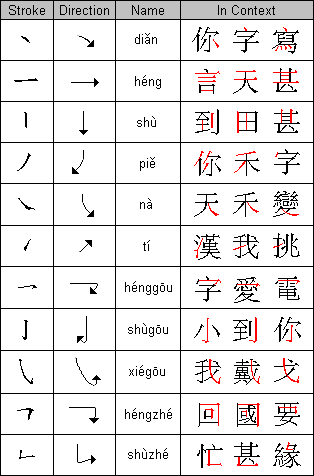A good first step in making Chinese characters less intimidating is identifying
their most basic parts.
A number of unique, identifiable strokes (individual marks of the brush or
pen) are used to write Chinese.
The chart below shows you the eleven most common strokes, giving the name and
direction in which each should be drawn.
In these examples, they are colored red (and very big!) to help you pick them
out.
Did you know that the name of China's
capital, Beijing, or


(bĕi jīng),
means "North Capital?" It's true. And the Chinese city Nanjing, or


(nán jīng),
means "South Capital."


(dōng jīng),
or "East Capital," is actually in Japan. Most people know it by its
Japanese pronunciation: "Tokyo."
And as for "West
Capital," I don't believe there is a city called Xijing, or


(xī jīng).
But I think we need one. Therefore, I would like to nominate Seattle for a name
change.
Seattle is commonly translated as

(xī yă tú), just to get something that sounds like the name "Seattle,"
though

(xī
yă tú) literally means "West Refined Picture," or maybe "West
Elegant Graph."
I don't think this literal meaning
is what the translators had in mind, but I rather like it: "West Refined
Picture." Catchy!





